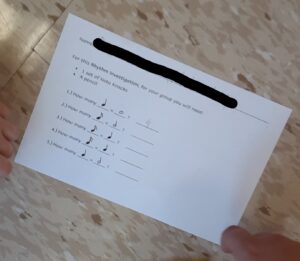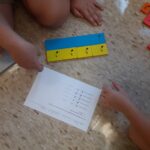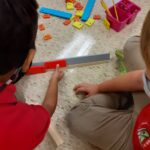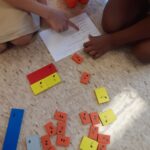I love giving students activities that require them to explore and analyze a problem! When they come to the answer themselves, they are more likely to remember it.
A couple of weeks ago my first and second graders started asking questions and making guesses about the relationships between notes:
- “If 2 yellows = 1 red, then how many yellows = a blue?” I asked them to estimate the answer first before we figured it out with Note Knacks.
- “If a whole note = 4 beats, then a half note must = 2”.
…and so on.
I wanted them to continue this inquiry, but in a way that required them to work together. My solution? Rhythm Investigation 1. I sent them off into small groups with a set of Note Knacks, a pencil and 5 questions.
All the questions used conventional notation and all the answers were whole numbers. The purpose of using conventional notation was for kids to start noticing the differences in notation. (This isn’t to say that I will only use conventional notation from now on, but I like to have kids work with it once in a while to prepare them for what is ahead.) I was so thrilled that they did a great job and enjoyed figuring out the answers, as it felt like a game (you could absolutely turn this into a game for 2 teams).
This kind of activity is the whole reason why I created Note Knacks! Kids can find the answers to their questions without having to remember what we tell them. THEY work with the materials, THEY figure it out using trial and error, THEY come to the conclusions either on their own or within the group. This helps to build self confidence in a discipline that often is considered beyond one’s reach unless he/ she has IT ~ whatever that is!!
Next step possibilities:
- Change the time signature for older kids and have an eighth = 1 beat.
- Have answers be fractions (you’re welcome math teachers!!!).
- Have kids make up their own questions to give to the group.





0 Comments